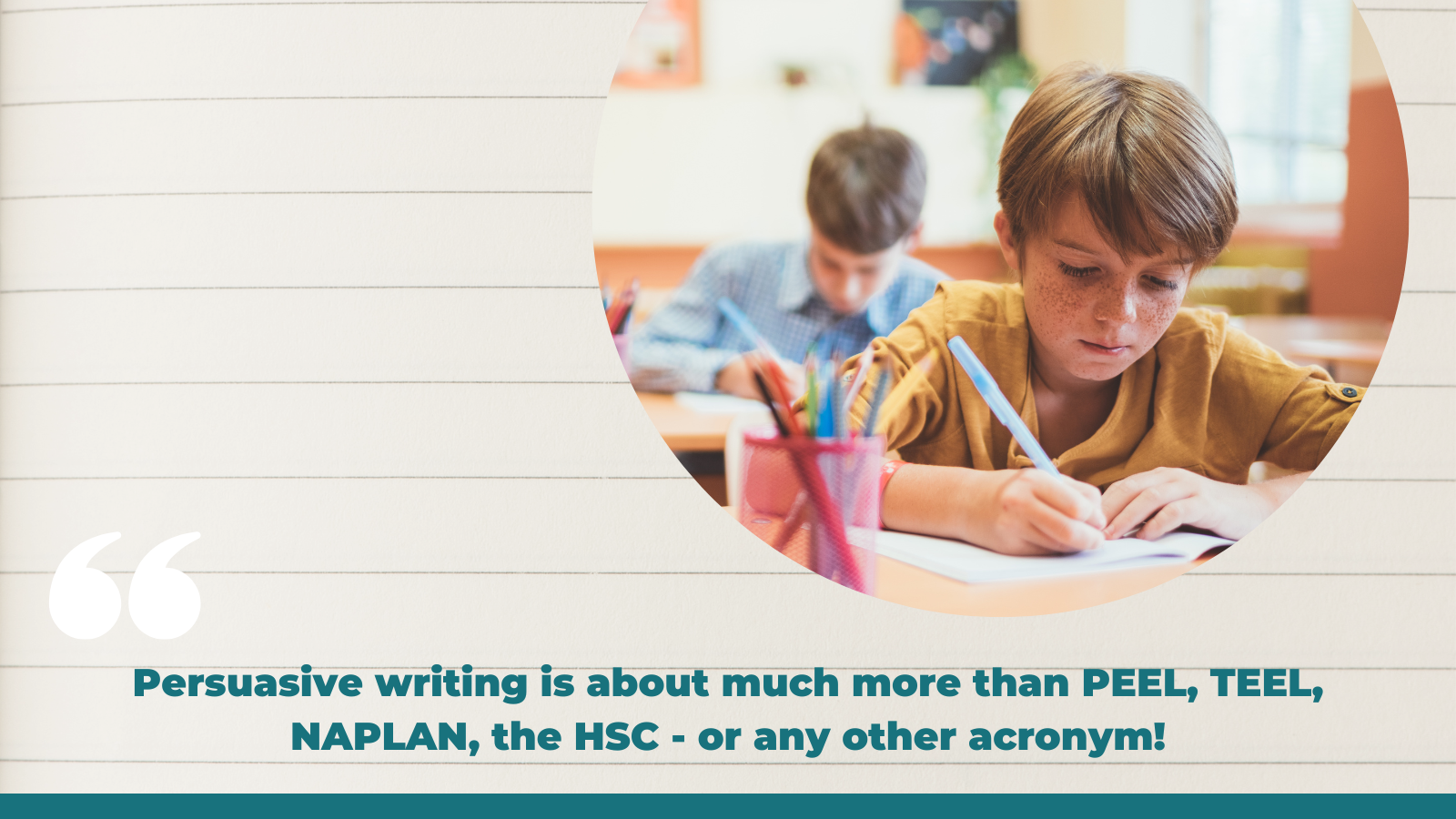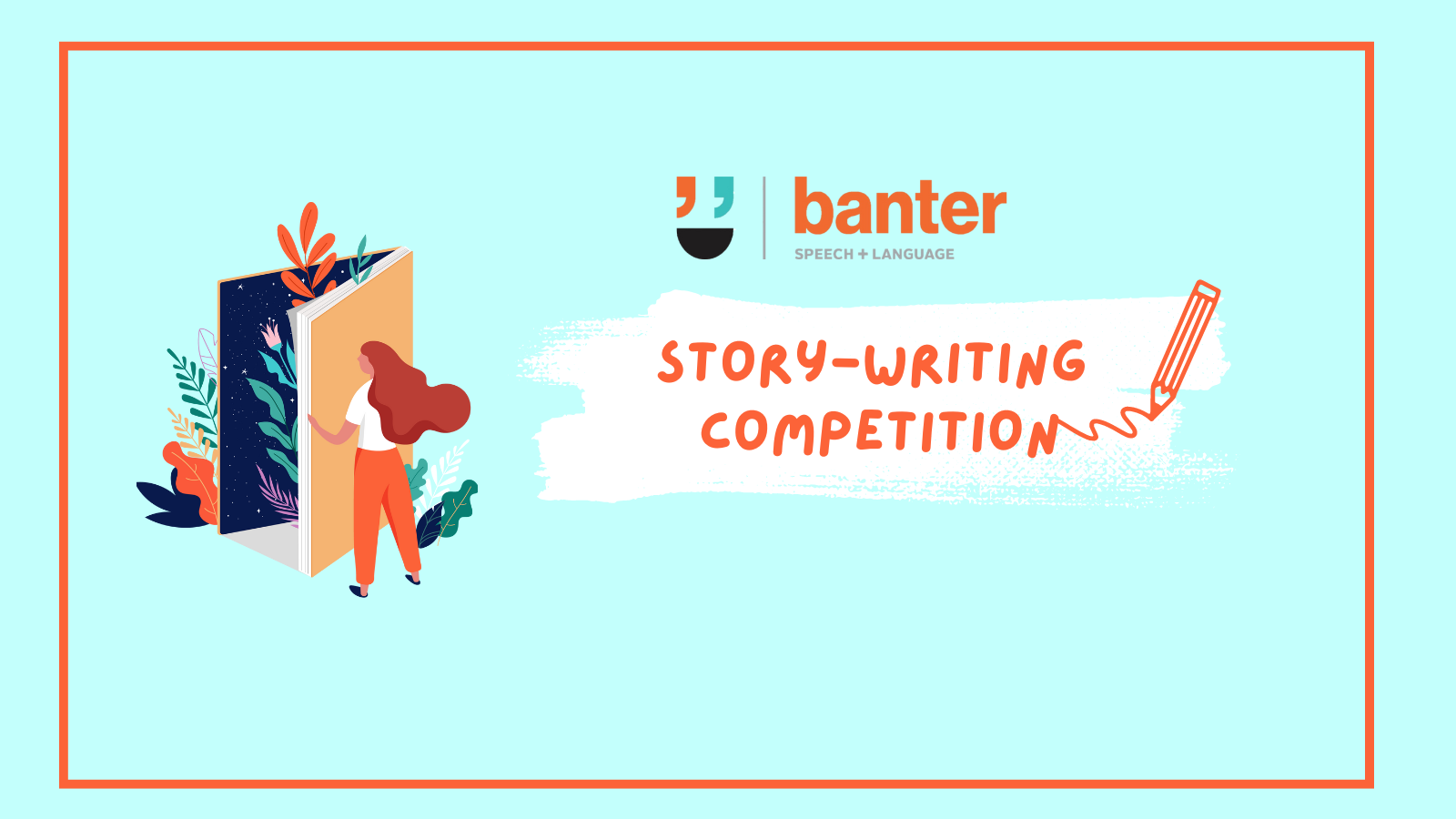Persuasive writing is about much more than PEEL, TEEL, NAPLAN, the HSC – or any other acronym!
If you can convince other people that your opinion is correct, you have a big advantage in life.
Learning to write strong, persuasive arguments can help you to participate and succeed, including as a student, employee, business owner, consumer, vendor, and citizen. It’s a useful skill in many face-to-face and in online settings, including in community meetings and on social media platforms like YouTube, Twitter, and Instagram.
In a democracy, communities, states, and nations benefit from the spirited interactions of informed individuals exchanging different perspectives with arguments that acknowledge and evaluate different views rationally, supported by evidence. Sadly, this is often not the case, with increasing levels of political polarisation and a decreasing tolerance for rational debate around a range of important social, economic, health, scientific, religious, intellectual, human rights, and environmental issues.
For students, learning to write arguments has an additional and more concrete benefit: it’s the main form of assessment in many school subjects, including many humanities subjects in the Higher School Certificate (HSC). In general, argumentative essays become more frequent and important for students as they progress through school.
In Australia, the National Assessment Program – Literacy and Numeracy (NAPLAN) has a big – and some think outsized – influence on how argumentative essays are taught and tested. NAPLAN requires students in Years 3, 5, 7, and 9 to write an argument or a narrative in response to a provocative prompt, e.g. that “Too much money is spent on toys and games”.
In practice, many teachers dedicate lots of class time preparing students for NAPLAN writing tests. Some teachers are expected to “teach to the test” by reverse-engineering NAPLAN writing tasks by reference to marking criteria.
1. How do teachers in Australia evaluate whether an essay is persuasive?
There are many ways of assessing writing quality. For example, in our speech pathology practice we use norm-referenced, standardised writing tests, informal discourse level probes (e.g. adapted from researchers like Koutsoftas and Gray), and our own in-house criterion-referenced test to look at students’ writing strengths and challenges. We then work with clients and families to set functional writing goals, and to plan intervention, using an explicit, direct approach to teaching writing.
In Australia, we also look at the NAPLAN Persuasive Writing Marking Guide and the Australian Curriculum: English. These documents are both influenced by an academic theory of language and argument called systemic functional linguistics (SFL).
I doubt many people outside the education sector know much about SFL. Even as a speech-language pathologist, I didn’t know much about the extent of its influence on how writing is taught and tested in Australia until I read a terrific recent paper by Damon Thomas from the University of Queensland (reference below).
It’s worth looking at SFL and its claims, briefly, because the theory has a real world effect on the way that many primary and secondary students are taught to write essays in Australia. It also helps us to understand the jargon used to describe and evaluate persuasive writing.
2. We write differently for different purposes
In (very) simple terms, SFL looks at the relationships between language and its functions in different contexts. It shares many common features with models of oral language used by speech pathologists in oral language therapy, including Bloom and Lahey’s famous model of language form, content and use.
SFL is often depicted like this:
Source: Thomas (2022)
Without doing a deep dive into all the jargon, this is not the clearest model – unless you are a linguist.
In basic terms, SFL seeks to connect language structure (e.g. phonology, syntax) and content (e.g. vocabulary and semantics) with its purpose (function) in different real world situations and cultural contexts (e.g. real world social or academic situations). A detailed analysis of SFL and its claims is beyond the scope of this article, but you can read more about it here, here and in the research referred to below.
3. We write things for three main purposes: to engage, to inform, and to persuade
In SFL, written texts are typically grouped into three broad categories, based on function or purpose:
- Texts that engage, e.g. recounts and narratives;
- Texts that inform, e.g. explanations and reports; and
- Texts that evaluate, e.g. arguments and responses that persuade.
Over time, writers of written genres (types of text) have evolved different structures to achieve their different purposes. To become effective writers, students should be taught about these different structures, and practice writing different types of texts that are appropriate for the purpose and context. This insight has a big effect on the way the Australian Curriculum approaches writing instruction – from Kindergarten to the end of Year 12.
4. There are four sub-types of persuasive writing
In this article, we’re focused on the structure of one subcategory of texts that evaluate: argumentative texts, also known as persuasive writing or persuasive texts. According to SFL, there are four sub-types (or genres) of these texts, which again differ in structure based on their purpose:
- Analytical expositions, written to persuade readers to believe one perspective on an issue. For example, a student might be asked to explain their views on whether mobile phones should be allowed in the classroom.
- Hortatory expositions, written to persuade readers to take some action based on the writer’s position. For example, a student might be asked to write an essay to persuade (“exhort”) others to stop using plastic straws.
- Discussions, written to discuss an issue from more than one perspective and to persuade readers to agree with one position. For example, a student might be asked to consider and evaluate arguments for and against Australia becoming a republic and to reach a well-reasoned conclusion.
- Challenges, written to rebut an established position. For example, a student might be asked to argue that the minimum age for voting should be reduced to 16 years in the jurisdiction in which they live.
5. How many Australian students are taught to structure their persuasive writing responses: The five-paragraph structure and ‘PEEL’ paragraphs
The structures of analytical, hortatory, discussion and challenge expositions are all slightly different, reflecting their different purposes. For example, the discussion text explicitly requires students to look at issues from multiple perspectives. Despite these differences, however, effective persuasive writing across the different genres typically involves writing texts with five main parts (or stages), in the following sequence:
- An introduction or thesis, usually including a statement of the student’s position and a preview of the arguments supporting it.
- Three (or more) arguments to support the student’s position, with each argument composed of a paragraph structured as follows:
- Point or Topic of the argument;
- Elaboration and explanation of the point;
- Evidence for the point, including examples; and
- Linking sentence, which connects the point back to the student’s thesis and/or to the next paragraph.
- A conclusion or reiteration composed of a review of the main arguments, and a restatement of the student’s thesis or position.
This observation, derived from SFL, has led many Australian teachers to focus on teaching their students:
- the so-called five paragraph essay structure; and
- PEEL (or TEEL) paragraph writing structures for their arguments in essays, made up of Point (or Topic), Elaboration, Evidence, and Link. (I prefer ‘PEEL’ over ‘TEEL’ as it helps some students to distinguish the specific point being made in an individual argument/paragraph from the overall topic of the essay.)
In Australia, many high school teachers focus on teaching PEEL paragraph-writing to students. It is especially common to see students practising PEEL paragraph writing as they prepare for NAPLAN tests in Years 7 and 9.
6. An example PEEL paragraph
Let’s say a student in Year 7 decides to disagree with the prompt that “too much money is spent on toys and games”. In the first paragraph, she states her position (her thesis) and then previews her main arguments, stating that “Many toys and games help children to develop skills and fitness (argument 1), do not cost much money compared to other expenses like food and housing (argument 2), and can help bring families together, improving family life (argument 3). In paragraph two, the student might write a PEEL paragraph to state her first argument:
| Some toys and games are good value for money because of the benefits they create for children. Toys and games can educate and improve children’s patience, skills, fitness and social skills. For example, jigsaw puzzles help children to stay patient and focused; literacy games help children to learn how to read; games like Operation and marbles can help children to practice their hand-eye coordination; skipping ropes can help children to get and stay fit; and board games like Monopoly help children learn how to deal with winning and losing with grace. Money spent on toys and games like these is well spent, and not too much, in light of the benefits received by the children who use them. Colour legend: Point/Topic Elaboration Examples/evidence Link to thesis |
7. There is much more to persuasive writing than the five-paragraph structure + PEEL
Unlike with speech and oral language, we are not biologically primed to learn to write. Students need to be taught how to do it. We’ve long advocated for explicit, sequenced writing instruction for all students, starting in Kindergarten. However, while explicit teaching of essay structures and PEEL can be helpful for beginners, it has also been criticised.
Some researchers think an over-emphasis on the five paragraph structure and PEEL:
- constrains students’ writing development, forcing students to write ‘colour-by-number’ essays that slavishly follow predictable ‘formulae’ that dictate what they should write sentence-by-sentence;
- forces teachers to teach it as ‘the correct way’ to maximise NAPLAN and HSC results by gaming the marking criteria; and
- may even have contributed to declines in writing outcomes.
In practice – working mainly with children with language and learning difficulties – we sometimes see students come to us trying to apply the PEEL formula without understanding the question. From time to time, we meet students who arrive at language therapy with pre-prepared, memorised essays (complete with quotes), with rigid plans to dutifully copy them out regardless of the question asked! This is – obviously – a terrible misuse of PEEL.
In writing, there is no single correct way to persuade – or, for that matter, to entertain, instruct, or explain things. Generations of students have learned to write persuasively without SFL concepts like PEEL.
In the recent study cited below, Thomas looked at the structural features of 60 high-scoring arguments written by students in Years 3, 5, 7 and 9 as part of NAPLAN. He found, amongst other things, that many high-scoring students used the five-stage structure for their essays. However, he also found that many of them used a wider range of techniques and structures for their arguments and produced arguments that were longer and more nuanced. Further, many high scoring students didn’t include all elements of PEEL in their arguments. Notably, only three of the 60 essays included Link phrases.
Expert writers go far beyond PEEL. For example, take a quick look at the different structures and approaches used by essay-writing masters in this very small and unrepresentative selection of essays:
- “Does Truth Matter? Science, Pseudoscience and Civilisation” by Carl Sagan
- “Death of the Moth” by Virginia Woolf
- “The Meditations” by Marcus Aurelius
- “How to use the Power of the Printed Word” by Kurt Vonnegut
- “On the Vanity of Words” by Michel de Montaigne
- “Once More to the Lake” by E.B. White
- “How to Do What you Love” by Paul Graham
- “On Self-Reliance” by Ralph Waldo Emerson
8. The cognitive demands of persuasive writing
In contrast to the expert essays linked above, many primary and high school essays are one-sided and poorly supported. It takes a lot of time and effort for students to develop the cognitive skills necessary to write sophisticated argumentative essays.
Many students need to be taught explicitly how to look at issues from multiple perspectives. Many are likely to require significant teacher modelling and scaffolding to start with. For example, research tells us that:
- primary school-aged students rarely consider alternative perspectives when writing persuasive texts;
- many adolescents struggle to integrate multiple perspectives in their essays; and
- many older adolescents are unable to acknowledge and respond to counter-arguments in their writing.
Using our example above, our Year 7 student might have several good arguments to support her thesis against the idea that “too much money is spent on toys and games” but find it difficult to acknowledge in her essay that:
- other people think that too much money is spent on toys or games; and
- there are good reasons to think they might be right, e.g. amount of annual toy waste, high average number of toys owned by children, money could be spent on other things like education, health and family experiences.
Many people finish school and reach adulthood without learning to look at issues from more than one perspective or to anticipate or rebut counter arguments with evidence and reasons. We see the adverse effects of this problem play out daily in social media exchanges, especially on Twitter and Facebook!
To write persuasively, a student must learn:
- to accept that different people think different things from the student about all kinds of issues;
- to reflect on biases and the limitations of the student’s knowledge;
- that many real world issues are complex and nuanced, requiring sophisticated responses, trade-offs and an understanding of real world constraints;
- to use high quality evidence and reason to formulate, state and substantiate their position on a position; and
- anticipate, consider, and rebut counterarguments respectfully and with humility.
Over time, students (and adults) must learn how to consider different perspectives and arguments, to appraise multiple sources of (sometimes conflicting) evidence of varying quality, and to evaluate and make judgments between contrasting views.
9. The many language demands of persuasive writing tasks
In high school, persuasive writing tasks, including many NAPLAN and HSC exams, require advanced and higher level language skills. To even understand the question, students need:
- oral comprehension skills, including well-developed background knowledge and inferencing skills, phonological, syntactic and semantic knowledge; and
- adequate reading skills, including work recognition skills.
In addition to understanding the structure of argumentative essays, students need to plan and structure written responses using appropriate:
- simple, compound and complex sentences, and other complex syntax like relative clauses, that help provide the ‘machinery’ for students to express complex, nuanced ideas like “Although some people think that too much money is spent on toys and games, the better view is that money is often well spent on toys and games for several reasons including…”;
- well-formed paragraphs (see also, paragraph models, and descriptive paragraphs, and recounts);
- persuasive devices, including:
- rhetorical devices, like logos, pathos, ethos, rhetorical questions, repetition, anaphora, onomatopoeia, and synecdoche;
- other higher level language and figurative language techniques like similes and metaphors, idioms, sayings, alliteration, assonance, personification, analogies, allusions, and hyperbole;
- humour, irony and sarcasm;
- vocabulary, including use of key academic verbs, and specific nouns and verbs and academic vocabulary generally;
- cohesion, including verbal reasoning practice, linking ideas in different ways, e.g. with different combinations of because/but/so, before/after/until, if/while/although, despite/in spite of, and otherwise conjunctions and adverbs, transitions, and referring words (like pronouns, articles, determiners like “much” and “many”), categories and semantic features;
- punctuation, e.g. capital letters and full stops, proper noun capitalisation, quotation marks); and
- spelling.
In some subjects, students also need to understand the language used in the text they are writing about, e.g. narrative structure for novels in English; as well as how to understand their school texts as a condition to writing about them.
This is all no small feat – especially for students with developmental and other language disorders, specific learning disorders (reading and/or writing) – and other neurodevelopmental disorders like ADHD or autism, and some students with lifelong communication disabilities.
Bottom line
To prepare students for school success, the workplace, citizenship, and adulthood we need to teach them good argumentative writing skills, including how to tackle persuasive writing tasks at school. We’ve outlined some of the theories that underpin many teachers’ approaches to teaching and testing persuasive writing in Australia. We’ve also highlighted some of the cognitive and language challenges that make persuasive writing tasks so challenging for many students – especially in high school.
Teaching beginners the five-paragraph essay structure, and the ‘PEEL’ paragraph writing strategy may assist. However, as students master the basics, they should be encouraged to look beyond these supports, to look at issues from multiple perspectives, and to use a greater variety of language structures and devices flexibly to improve the effectiveness of their writing and the persuasiveness of their arguments.
Main source and recommended further reading: Thomas, D.P. (2022). Structuring written arguments in primary and secondary school: A systemic functional linguistics perspective, Linguistics and Education, 72, accessed online: https://doi.org/10.1016/j.linged.2022.101120.
This article also appears in a recent issue of Banter Booster, our weekly round up of the best speech pathology ideas and practice tips for busy speech pathologists, providers, speech pathology students, teachers and other interested readers.
Sign up to receive Banter Booster in your inbox each week:

Hi there, I’m David Kinnane.
Principal Speech Pathologist, Banter Speech & Language
Our talented team of certified practising speech pathologists provide unhurried, personalised and evidence-based speech pathology care to children and adults in the Inner West of Sydney and beyond, both in our clinic and via telehealth.








